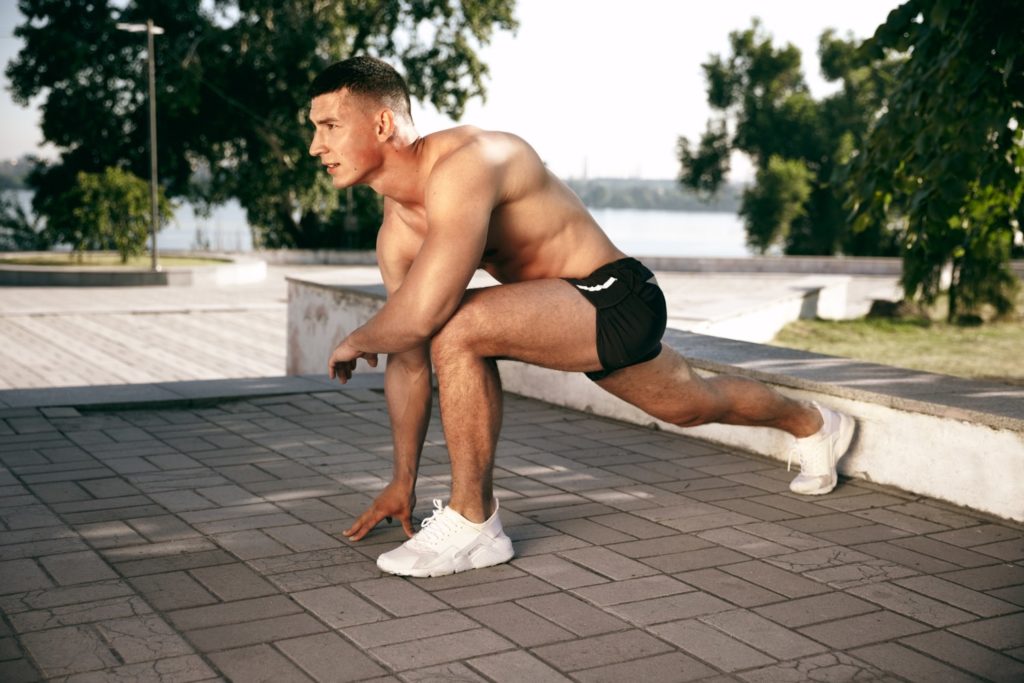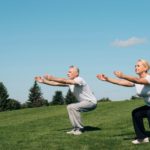
Grant Hansen
(RCEP, CHEK Exercise Coach, CHEK Holistic Lifestyle Coach Level 1)
The quad muscles are important for a variety of movements. As discussed in an previous article, quads can cause movement restriction and lead to injuries, and, later in life, tripping and falling.
There are several issues that can occur, however, we will focus on the two most common, which are:
- Quad strain
- Quad contusion
- Quad tendonitis
- Patellofemoral pain syndrome[1]
Before heading off to the gym, we would encourage you to read the rest of the article.
Quads strain
The rectus femoris is the most frequently strained quad muscle.[1] There are several factors, which predispose the rectus femoris muscle, and others, to more frequent strains. These include the muscles crossing two joints and quad muscles with a high percentage of Type II fibers (fast-twitch).[2,3]
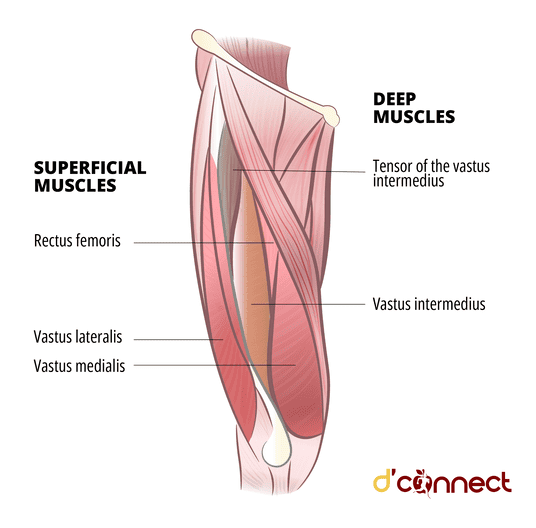
Muscle fatigue has also been shown to play a role in acute muscle injury.[4] From these factors muscle fatigue is the one factor that we can have an influence on through physical conditioning and can train our muscular endurance to help decrease the risk of injuries.
The classification of quadriceps strains
Mild (Grade 1) – minor tearing of muscle fibers. None or minimal loss of strength. No palpable muscle defect.
Moderate (Grade 2) – more severe disruption to the muscle fibers, with significant pain and moderate loss of strength. May feel a small palpable muscle defect.
Severe (Grade 3) – complete tearing of the muscle, severe pain. Usually complete loss of strength. Often feel a palpable muscle defect.[1]
Quad strains occur when the muscle fibers are stretched or torn
Symptoms may include pain, swelling, and result in a limited range of motion.[1]
Quad strain recovery
Acute recovery phase (first 24–72 hours) focuses on minimising bleeding into the muscle by following the RICE principle (rest, ice, compression, and elevation).
Compression has been shown to decrease blood flow and when combined with elevation will serve to decrease both blood flow and excess build up of fluid in the tissues known as interstitial fluid accumulation.[1]
Cryotherapy, accompanied by compression, should be applied for 15–20 minutes at a time with 30–60 minutes between applications. During this phase, the quadriceps should be kept relatively immobile to allow for healing and prevent further injuries.[1]
Pain relief medication such as non-steroidal anti-inflammatory drugs (NSAIDs) may be useful for reducing pain and allowing earlier return to activity. Recent review recommends only a short 3–7 day course of NSAIDS after muscle strains.[5,6,7]
Active recovery phase (approximately 3–5 days after acute injury) focuses on stretching, strengthening, range of motion, maintenance of aerobic fitness, proprioceptive exercises, and functional training.
Quad contusion
Contusions are caused by a blunt blow (severe impact). The impact this has on the depth of the injury and the effect on function is due to the force of the impact and the degree of thigh relaxation.[1]
Signs and symptoms of a quad contusion are pain, transitory (not permanent) loss of function, immediate effusion (too much fluid in the muscle) with a swollen area that can be felt.[1]
The classification of quadriceps contusions
These are graded 1-4, or from superficial to deep, with increasing loss of function (decreased ROM, strength).[1]
The average disability time for mild contusions is 13 days. For moderate contusions is 19 days and 21 days for severe contusions.[8]
An important condition to be aware of with quad injuries is myositis ossificans. This occurs in 9 and 17% of severe quadriceps contusions and should be suspected if the symptoms get worse after 2–3 weeks.
There is loss of knee flexion and swelling remains, while the symptoms include pain, weakness, swelling, tissue tension, point tenderness with decreased range of motion (ROM).[1]
Quad contusion recovery
The treatment for quadriceps contusions is similar to the recommendations for quadriceps strains, with one key difference.
The injured leg should be placed in a position of flexion for the first 24 hours post-injury to limit hematoma formation.[1]
A hematoma occurs when blood leaks from the large blood vessels causing symptoms such as pain, swelling and redness. A physiotherapist is recommended to help with the treatment protocol of the acute injury.[1]
The physiotherapist may place the injured leg in a hinged knee brace at 120° of knee flexion or using elastic compression wrap to maintain this position of flexion.
This needs to be done as soon as possible after injury. In addition to maintaining this position of flexion, ice and compression should be applied during this period.[1]
Quad contusion return to activity
The guidance for returning to activity is similar to muscle strains. You must have no pain, be able to flex your knee 120° with your hip extended, and complete functional testing without limitations.[8]
Quad tendinopathy
This is an overuse injury known as patella tendinopathy, otherwise called jumpers knee as of the high occurrence in athletes. This injury involves inflammation of the quadriceps tendon that connects the muscle to the knee.
The condition can cause pain in the knee cap, typically the top of the knee cap.
Injury often occurs during activity where there is repeated stress, loading and knee extension (straightening the knee such as jumping).[9]
Patellofemoral pain syndrome
This condition is sometimes referred to as runner’s knee as it is more common in people participating in sports such as running and cycling.
The condition can also develop due to quad muscle imbalances, tightness and weakness.
Overtraining can lead to injury
The symptoms include the pain around the kneecap, felt during activities such as running and jumping.
You may experience pain, tenderness under the kneecap or aching in the front of the knee and the feeling as if the knee may give out.[10]
Preventative Quad Exercises
We can help to prevent injuries and strains by performing strengthening and stretching exercises for the quads and hips.
The strengthening helps the joints to have less loading on them. With consistent strength training, you may be able to reduce the pain and improve how your knee joints function.[10]
Isometric exercises for quads
This is where there is no movement of the knee or hip. The muscle contraction is against a fixed object resulting in no change in muscle length.[1]
How to do isometric exercise for quads
An example of how to do this is to tighten quadriceps with the knee in an extended position. Hold the contraction for 5 to 10 seconds and repeat ten times every hour.
The intensity is guided by time since injury as well as pain levels. As the muscle heals, increase intensity as much as possible.
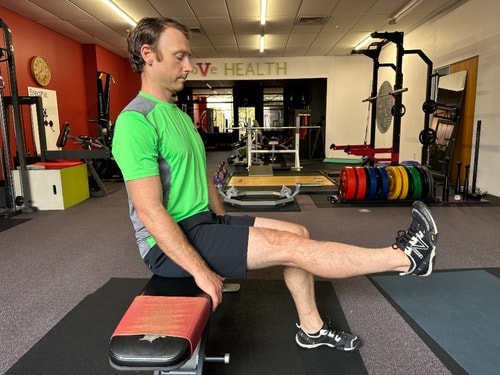
RELATED — Exercise Guide to: Sturdy Quads
Isotonic exercises for the quads
This is a progression from isometric exercise. If you are unsure about when to start this phase consult with a physiotherapist who is supporting your injury recovery.
Here, the muscle contraction is against a constant resistance with uncontrolled speed of movement, resulting in shortening or lengthening through the movement.
These exercises can be performed with:
- body weight
- free weights (such as a dumbbell)
- resistance exercise machines
Key benefits of isotonic exercises are that this allows the joint to go through a wide range of motion so it has more application to everyday movements.
Progress the weight by no more than 1kg to 1.5kg.
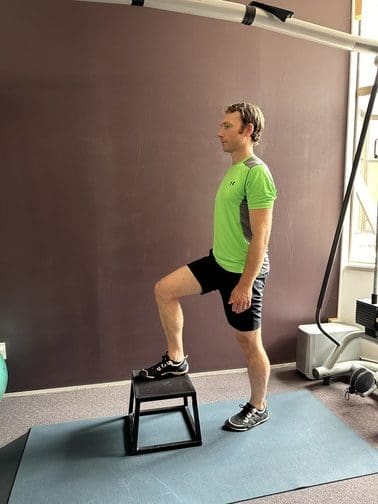
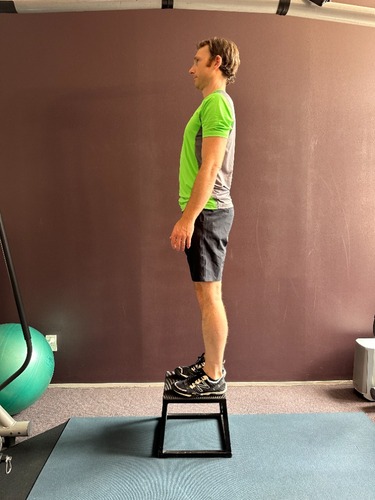
How to do isotonic exercise for quads
This is a common method of resistance training and involves moving a joint through a range of motion while the muscle is under tension.
For example, this can be holding a dumbbell while doing a split stance lunge, or doing a machine leg extension or even just a bodyweight squat.
Begin with the lightest weight where you can manage 3 sets of 10 reps. Aim to hold the end position of the movement for 3-5 seconds before returning to the start position.

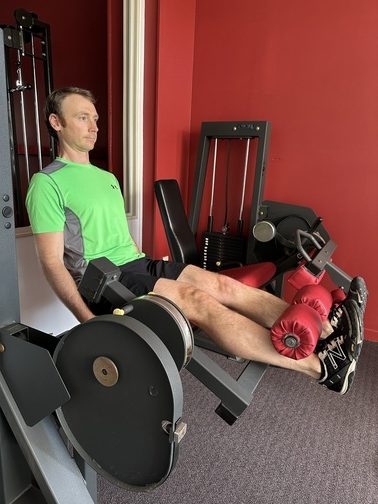
Isokinetic exercises for the quads
Here, the muscle contraction is through a range of motion at a constant angular velocity.[1] Research shows that isokinetics produce more functional outcomes compared to isometric and isotonic exercises.[11]
How to do to isokinetic exercises for quads
This often involves specialised machines and seeking guidance from a training professional such as a physiotherapist. Generally, a dynamometer machine measures the force generated through the movement, which stays constant.
All strengthening exercises should be performed through a pain-free range of motion. Progression of each type of strengthening depends on the level of soreness and pain created by each type of exercise.
Quads and stretching
Stretching is recommended, however it should be done carefully and only to the point of slight discomfort.
Various techniques can be utilised including passive, active–passive, dynamic, and proprioceptive neuromuscular facilitation stretching.


Ballistic stretching (where you extend your joint as far as possible to lengthen the targeted muscle groups) is discouraged due to the risk of re-tearing muscle fibers.
An active warm-up should always be completed before any type of rehabilitation exercises as it has shown to activate neural pathways in the muscle and reduce muscle viscosity.
Static stretching exercises for quadriceps flexibility. Research has shown that tight and overactive hip flexor muscles can inhibit your gluteus maximus by 60%.
Restricted (tightness) of the hip flexor muscle is a risk factor for various lower extremity musculoskeletal injuries.
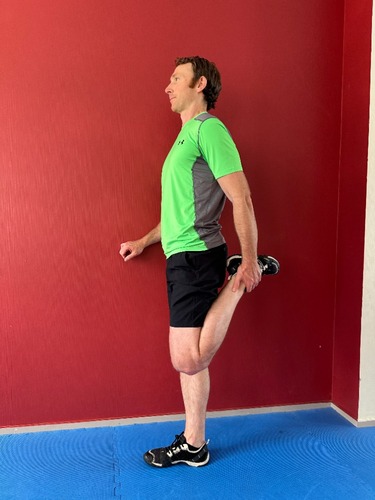
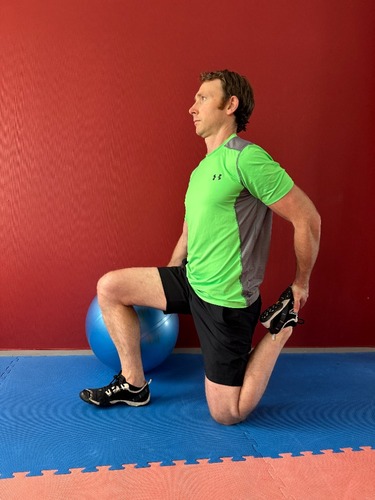
For the standing hip flexor stretch example, to help target the hip flexor, ensure you rotate the pelvis backwards, as if you are flattening your lower back, so that you feel the tightness in the hip area.
Related Questions
1. What does quad overuse feel like?
The pain is often mild initially and can increase over time.
The pain tends to be dull and aching, and is noticeable more when strain is put on the knee such as going up or down stairs or doing activities that bend the knee frequently.[10]
2. What is the difference between a pulled and torn quad?
The torn quad is a much more severe injury compared to the pulled (strained quad).[12]
A torn quad is a rupture or tear of the quad tendon. These can be graded from partial to complete tear. A partial quad tear can sometimes be managed without surgery, whereas a complete tear will require surgery.
3. What helps with quad cramps?
The most common theories include dehydration and not having a proper balance of electrolytes.
If you are exercising or sweating, electrolyte-containing drinks are recommended.[13,14,15] A treatment for cramps is passive stretching. The stretch can be held for 15-30 seconds and repeated 2-4 times.[16,17]
For similar articles, we suggest visiting the Activities and Performance section.
Grant is a registered Clinical Exercise Physiologist (CEP) and Holistic Lifestyle Coach. He has over 15 years of experience of working in New Zealand within the primary healthcare sector. After completing a Sports Science degree, Grant started working in the gyms around the North Island and was a Personal Trainer in Sydney.
On his return to New Zealand, Grant began working in a community health setting and completed further studies to become a Clinical Exercise Physiologist.
Grant believes that exercise is a keystone to living purposefully and with vitality, and integrating it into our life can help us create a balanced body and mind.
Grant walks with people on their health journeys, helping them discover the right type, dose, frequency and amount of physical activity. This is both an art and a science.
As a Clinical Exercise Physiologist, he specialises in delivering exercise, lifestyle and behavioural modification programmes with the goals of preventing, managing and rehabilitating individuals with chronic conditions, diseases and injuries.
Grant aims for people to navigate their way to self-management, which means that they have the confidence, knowledge and environment to maintain their physical activity without requiring a clinician ongoing. This is an empowering way of enhancing peoples’ well-being as it builds self-reliance and removes the need for external support.
Grant believes that the collaboration of clinical exercise physiologists with other health services is vital as working cohesively with a patient-centred approach will enhance community health outcomes.
Grant’s goal is to help people integrate exercise and lifestyle changes so they can live a purposeful, intentional and vibrant life.
References
(1) Kary. J.M., (2010). Diagnosis and management of quadriceps strains and contusions. Current Reviews in Musculoskeletal Medicine. https://www.ncbi.nlm.nih.gov/pmc/articles/PMC2941577/
(2) Mills, M., Frank, B., Goto, S., Blackburn, T., Cates, S., Clark, M., Aguilar, A., Fava, N., Padua, D. (2015). Effect of restricted Hip Flexor Muscle Length on Hip Extensor Muscle Activity and Lower Extremity Biomechanics in College-aged Female Soccer Players. Int J Sports Phys Int J Sports Phys Ther.
(3) Murdock, C J., Mudreac, A., Agyeman, K. (2019). Anatomy, Abdomen and Pelvis, Rectus Femoris Muscle. StatPearls Publishing, Treasure Island (FL). https://www.ncbi.nlm.nih.gov/books/NBK539897/
(4) Hughes, C., Hasselman, C T., Best, T M., Martinez., S., Garrett Jr, W E. (1995). Incomplete, intrasubstance strain injuries of the rectus femoris muscle. Am J Sports Med.
(5) Almekinders, L C. (1999). Anti-inflammatory treatment of muscular injuries in sport. An update of recent studies. Sports Med
(6) Health Navigator. (2023). Nsaid topics.
(7) Mehallo, C J., Drezner, J A., Bytomski, JR. (2006). Practical management: non-steroidal anti-inflammatory drug use in athletic injuries. Clin J Sport Med.
(8) J B Ryan, J H Wheeler, W J Hopkinson, R A Arciero, K R Kolakowski. (1991). Quadriceps contusion: West Point update. Am J Sports Med.
(9) TBI Health. Patellofemoral syndrome. Retrieved from https://tbihealth.co.nz/learn/quick-guides/legs/patellofemoral-syndrome/
(10) Patellofemoral pain syndrome (runner’s knee): overview. (August 13, 2020). Next update: 2023. Retrieved from https://www.ncbi.nlm.nih.gov/books/NBK561507/
(11) Lee SEK, Lira CAB, Nouailhetas VLA, Vancini RL, Andrade MS. J Bodyw Mov Ther. (2018). Do isometric, isotonic and/or isokinetic strength trainings produce different strength outcomes?
(12) Ludwig, b.j. (2023). Torn quad – quadriceps tendon rupture. The sportsmd editors. Retrieved from https://www.sportsmd.com/sports-injuries/hip-thigh-injuries/quadriceps-tendon-rupture/
(13) Maughan, R. (2020). Industry-presented webinar q&a | muscle cramping during exercise. Retrieved from; https://www.acsm.org/blog-detail/acsm-certified-blog/2020/03/03/muscle-cramping-during-exercise
(14) Mayo clinic. (n.d.). Treatment. retrieved from; https://www.mayoclinic.org/diseases-conditions/muscle-cramp/diagnosis-treatment/drc-20350825
(15) Miller, K., Stone, M., Huxel, H., Edwards, J. (2010). Exercise-Associated Muscle Cramps Causes, Treatment, and Prevention. Sports Health. https://www.ncbi.nlm.nih.gov/pmc/articles/PMC3445088/
(16) Schwellnus, MP., Derman, EW., Noakes.,TD. (1997). Aetiology of skeletal muscle “cramps” during exercise: a novel hypothesis. J Sports Sci.
(17) Page, P. (2012), Current concepts in muscle stretching for exercise and rehabilitation. Int J Sports Phys Ther. https://www.ncbi.nlm.nih.gov/pmc/articles/PMC3273886/
